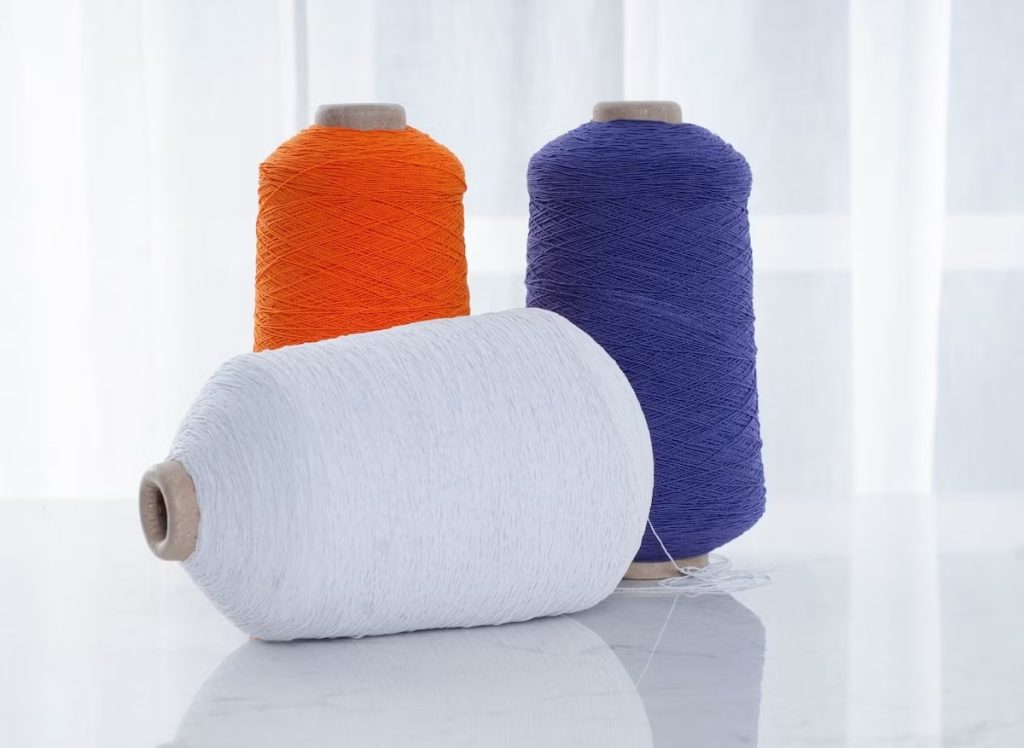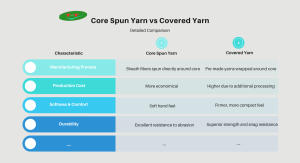In today’s textile and apparel industry, covered elastic yarn has become an essential material for creating durable, comfortable, and high-performance fabrics. From sportswear to medical textiles, this versatile yarn offers a perfect balance of stretch, resilience, and design flexibility.

If you are an apparel manufacturer, designer, or textile buyer, understanding covered elastic yarn will help you make better material choices and keep up with global market demands. On the other hand, selecting the wrong elastic yarn can lead to product returns, damaged brand reputation, and lost revenue.
This guide covers everything you need to know: definition, types, production methods, benefits, applications, comparisons, buying tips and future trends.
What is Covered Elastic Yarn? (Also Known as Core Spun Elastic)
Covered elastic yarn is a type of yarn where an elastic core—usually spandex (also called elastane)—is wrapped or “covered” with another fiber such as polyester, nylon, or cotton.
Main characteristics include:
- Elasticity: Provides high stretch and recovery.
- Durability: Maintains performance even after repeated use and washing.
- Comfort: Soft feel against the skin.
- Versatility: Can be combined with various fibers for different functions.
- Dyeability: Easily absorbs colors, offering design flexibility.
This structure makes covered elastic yarn ideal for products that require both stretch and stability.
Types of Covered Elastic Yarn
Covered elastic yarn can be classified based on three main factors: the elastic core, the covering fiber, and the yarn construction.
By Elastic Core
- Spandex-Covered Yarn: The most common type, offering excellent stretch, lightness, and comfort. Suitable for most fashion fabrics and sportswear.
- Rubber-Covered Yarn: Features a rubber core that delivers stronger elasticity but is heavier and less comfortable. Often used in technical textiles or applications requiring high compression.
By Covering Fiber
- Cotton-Covered Yarn: Provides a soft, breathable, and natural feel. Ideal for underwear, loungewear, and casual wear.
- Polyester-Covered Yarn: Known for durability, wrinkle resistance, and moisture-wicking properties. Perfect for sportswear and workwear.
- Nylon-Covered Yarn: Smooth, glossy, and abrasion-resistant. Commonly used in hosiery, premium lingerie, and fabrics that require a sleek finish.
By Yarn Construction
- Single-Covered Yarn: The elastic core is wrapped with one layer of fiber. Lightweight, flexible, and cost-effective. Frequently used in thin fabrics such as hosiery, tights, and underwear.
- Double-Covered Yarn: The elastic core is wrapped with two layers of fibers in opposite directions. Offers maximum stability, full core coverage, and excellent abrasion resistance. Ideal for waistbands, sportswear, and technical textiles.
How Is Covered Elastic Yarn Made?
The production of covered elastic yarn involves surrounding an elastic filament with other fibers to improve strength and usability.
Core Spinning Process
In this method, an elastic filament acts as the core, while one or more fibers are spun around it. This ensures the yarn retains elasticity while gaining surface softness and durability.
Single vs. Double Covered Yarn
- Single covered yarn: Elastic core wrapped once with fiber. Lightweight and commonly used in hosiery or underwear.
- Double covered yarn: Elastic core wrapped twice, often in opposite directions, for extra stability. Suitable for sportswear and technical fabrics.
Choosing between single and double covered yarn depends on the desired performance and application.
Why Should You Invest in Covered Elastic Yarn? Key Benefits for Manufacturers
Covered elastic yarn offers multiple advantages compared to bare elastic fibers or other yarns.
Strength and Stretchability
The combination of an elastic core and protective covering results in yarns that are strong, durable, and able to stretch significantly without breaking. Solves the problem of sagging waistbands in activewear after multiple washes, ensuring your products maintain a premium look and customer satisfaction. This high recovery elastic yarn is essential for brand reputation.
Comfort and Fit
Garments made with covered elastic yarn adapt naturally to body movements, ensuring better fit and greater comfort during wear. Eliminates skin irritation common with lower-quality elastic, making it ideal for comfort-focused applications like premium underwear and sportswear.
Versatility in Design
For product developers and designers, material limitations can stifle creativity. Covered elastic yarn turns this constraint into your greatest advantage.
You have to source multiple, specialized materials for different product lines (e.g., one yarn for sportswear, another for lingerie). This complicates your supply chain, increases minimum order quantities (MOQs), and slows down innovation.
Think of covered elastic yarn as a modular system. By simply changing the covering fiber, you can engineer a wide range of functionalities from a single, core production platform. This simplifies your sourcing and unlocks unprecedented design potential.
Key Applications of Covered Elastic Yarn
Understanding the “why” behind each application helps you select the perfect yarn for your product line.
High-Performance Sportswear & Activewear
- Application: Leggings, swimwear, compression wear, athletic shorts.
- Why it’s Ideal: The combination of high recovery and durability is critical. The yarn must maintain compression and shape through intense activity, chlorine exposure, and frequent washing. Double-covered yarns are often specified here for maximum stability.
Durable & Comfortable Waistbands and Cuffs
- Application: Waistbands in jeans, trousers, and shorts; cuffs on sleeves and ankles.
- Why it’s Ideal: This is the most demanding application for covered elastic yarn for waistbands. It requires exceptional recovery to prevent rolling or sagging. The covering protects the core from friction against skin and other garments, ensuring the waistband lasts the lifetime of the garment.
Premium Intimate Apparel and Hosiery
- Application: Bras, underwear, socks, tights.
- Why it’s Ideal: Skin contact demands a soft covered elastic yarn. The fine denier and smooth finish prevent irritation and provide a seamless, comfortable fit. Lightweight single-covered yarns are common in this category for flexibility and discretion.
Technical & Medical Textiles
- Application: Compression therapy garments, surgical stockings, protective workwear.
- Why it’s Ideal: These applications rely on precise, consistent pressure and long-term reliability. The controlled elasticity and durability of covered yarn meet strict medical and industrial standards, where failure is not an option.
Covered Elastic Yarn vs. Other Types
When compared to other elastic yarns, covered elastic yarn stands out:
- Covered vs. Bare Spandex: Bare spandex is highly elastic but lacks durability. Covering it with fibers improves strength, comfort, and appearance.
- Covered vs. Core-Spun Yarn: Core-spun yarns have a non-elastic core (like polyester) with fibers spun around it. Covered elastic yarn differs by having an elastic core, making it more suitable for stretch garments.
In short, covered elastic yarn offers a balance of stretch, stability, and comfort that other yarns cannot match.
Factors To Consider When Choosing Covered Elastic Yarn
Use this checklist to match the yarn’s properties to your product’s requirements.
Define the Core Requirement: Stretch vs. Recovery
- Ask Yourself: “What is more important for my garment: extreme stretch (like in swimwear) or powerful, consistent recovery (like in a waistband)?”
- Our Guidance: This determines the core material (spandex vs. rubber) and its denier. Higher denier cores offer more power but less stretch.
Select the Covering Fiber Based on Fabric Handfeel and Function
- Ask Yourself: “What is the desired handfeel (soft, crisp, slick) and what functional properties (moisture-wicking, breathability) are needed?”
- Our Guidance:
- Cotton: For softness, breathability, and a natural feel (ideal for loungewear, underwear).
- Polyester: For strength, durability, and moisture-wicking (ideal for sportswear, workwear).
- Nylon: For a silky handfeel, high strength, and abrasion resistance.
Specify the Construction: Single-Covered vs. Double-Covered
- Ask Yourself: “Will this yarn be used in a high-abrasion environment? Is a perfectly smooth surface critical?”
- Our Guidance:
- Choose Single-Covered: For lightweight fabrics, hosiery, and applications where maximum flexibility and low cost are priorities. The core may be slightly exposed.
- Choose Double-Covered: For heavy-duty applications like waistbands or sportswear where maximum coverage, durability, and a uniform appearance are essential.
Verify Quality and Compliance
- Ask Yourself: “Does my target market require specific eco-friendly or safety certifications?”
- Our Guidance: Always request test reports for key properties like shrinkage, elasticity, and colorfastness. Certifications like OEKO-TEX® Standard 100 (for safety) and GRS (for recycled content) are increasingly becoming market standards.
Buying Tips for Manufacturers
A Strategic Guide to Sourcing Your Elastic Yarn: Your yarn supplier is a partner in your quality chain. Here’s how to evaluate them beyond the price sheet.
- Tip 1:Start with Rigorous Sample Testing
- Don’t just look: Physically test the yarn and knit/weave it into your fabric. Perform stretch recovery tests, wash tests, and check for consistency.
- Tip 2:Assess Technical Support and Customization Capability
- Key Question: “Can you help me develop a custom yarn for my specific needs?”
- Why it matters: The best suppliers have technical experts who can advise on yarn selection, troubleshoot production issues, and develop custom solutions. This adds immense value that a simple trader cannot provide.
- Tip 3:Scrutinize Supply Chain Reliability
- Key Questions: “What is your lead time? How do you handle quality consistency across large batches? What is your contingency plan for disruptions?”
- Why it matters: Consistent quality and on-time delivery are more critical than a slightly lower price. A production line stoppage due to faulty or late yarn is far more costly.
- Tip 4:Negotiate Based on Total Value, Not Just Unit Cost
- Consider: A slightly more expensive yarn from a superior supplier might yield less waste, higher production speeds, and a better final product that reduces returns. Calculate the total cost of ownership, not just the purchase price.
- Tip 5:Plan for the Future: Inquire About Sustainable Options
- Ask: “Do you offer GRS-certified recycled polyester or other sustainable materials?”
- Why it matters: Getting ahead of sustainability trends future-proofs your products. Partner with a supplier who is already innovating in this space.
By following these tips, manufacturers can avoid costly mistakes and build stronger relationships with trusted yarn partners.
Future Trends in Covered Elastic Yarn
The demand for eco-friendly covered elastic yarn is rising. Key trends include:
- Sustainable materials: Use of recycled polyester or organic cotton as covering fibers.
- Advanced technologies: Improved spinning methods for higher quality and reduced energy consumption.
- Market growth: Rising global demand for sportswear, medical textiles, and eco-friendly fabrics.
Staying ahead of these trends can help businesses remain competitive in the evolving textile industry.
Conclusion
Covered elastic yarn is more than just a textile material—it is the backbone of modern stretch fabrics. Its unique combination of elasticity, comfort, and durability makes it essential for industries ranging from fashion to healthcare.
By understanding its definition, production, benefits, applications, and future trends, manufacturers and designers can make smarter choices and deliver products that meet both market and consumer needs.
Whether you are sourcing materials for sportswear, underwear, or medical textiles, covered elastic yarn is a reliable solution for quality and performance.
Ready to source high-quality, certified covered elastic yarn for your next collection? Contact our technical experts today for free samples and detailed specifications.



